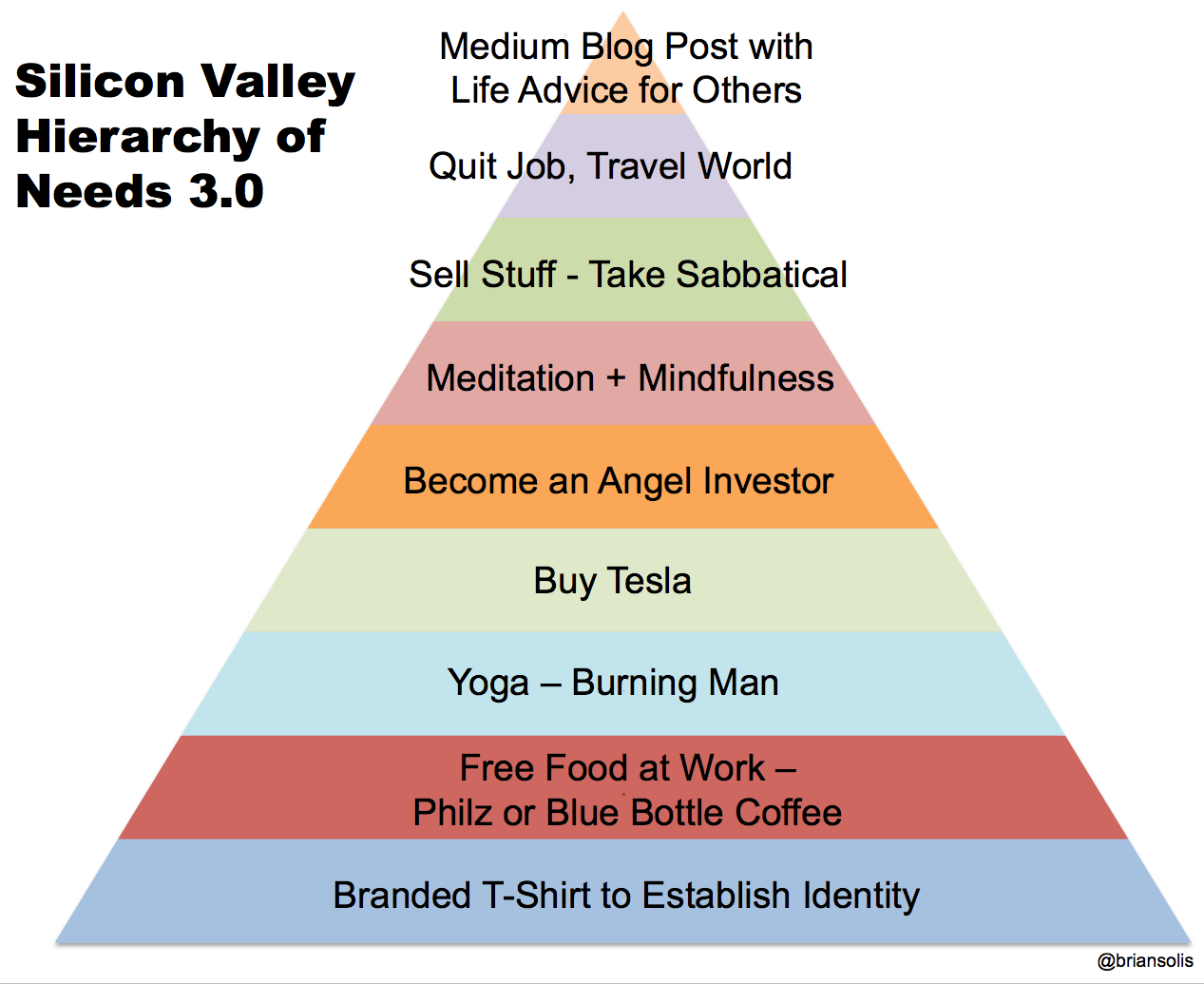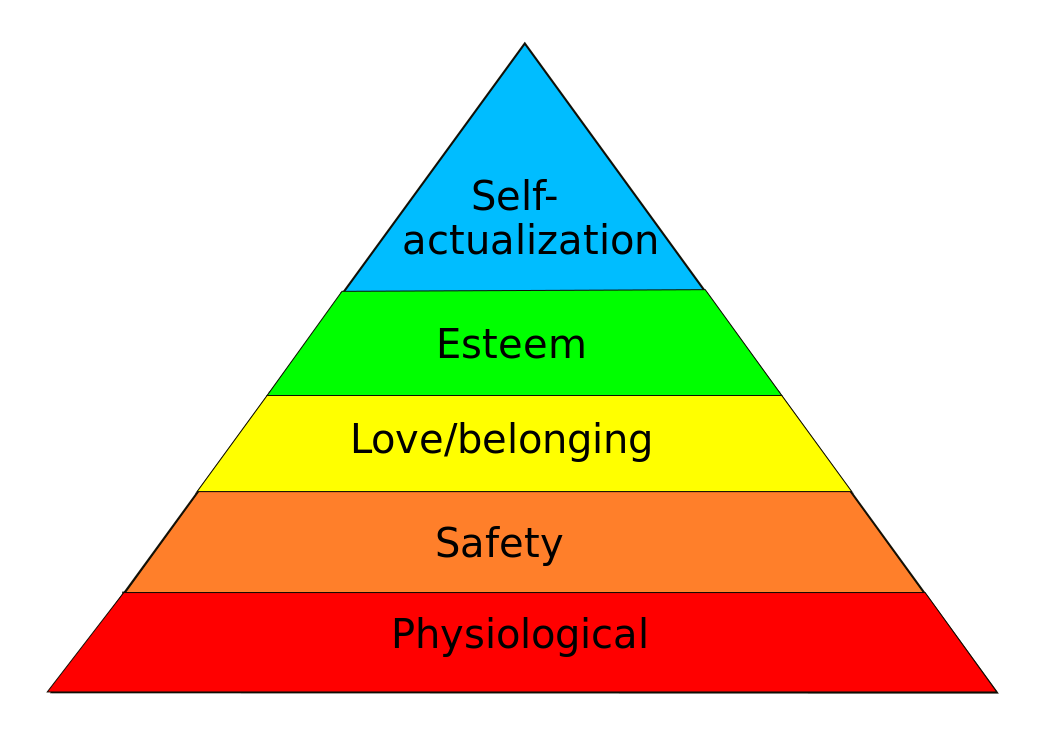
The other day, my friend Loic Le Meur shared a hilarious take on Maslov’s famous Hierarchy of Needs, simply called, “Silicon Valley Hierarchy of Needs.” For many, including me, the list of laughably superficial “needs” of those mocked in Silicon Valley are also a little too familiar or relatable. We all know that person, someone like them, or we’ve seen them characterized in spoofs, TV, movies, books, etc.
As a refresher, Abraham Maslov’s Hierarchy of Needs were inspired by his work seeking to understand what motivates people. He believed that a set of motivation systems are inherent in all of us unrelated to rewards or unconscious desires. As we achieve one need, we seek to fulfill the next one and the next one.
The most widespread, and earliest version of Maslow’s Hierarchy of Needs features five motivational needs stacked as levels.
The model, most often depicted as a pyramid, includes the following needs (starting from the bottom):
1. Biological and Physiological needs – air, food, drink, shelter, warmth, sex, sleep.
2. Safety needs – protection from elements, security, order, law, stability, freedom from fear.
3. Love and belongingness needs – friendship, intimacy, affection and love, – from work group, family, friends, romantic relationships.
4. Esteem needs – achievement, mastery, independence, status, dominance, prestige, self-respect, respect from others.
5. Self-Actualization needs – realizing personal potential, self-fulfillment, seeking personal growth and peak experiences.
Silicon Valley Hierarchy of Needs
The original Silicon Valley Hierarchy of Needs was meant to poke fun at an often indifferent or isolated ecosystem of entrepreneurs, investors, mentors, marketers lawyers and everyone in between. It hits home. By the way, I tried to find the source to properly credit the original parody. If you can help, please share in the comments and I’ll update accordingly.
Silicon Valley is in fact home for me and I have lived through all of the trends both good and bad going back to the pre-Internet Gold Rush. At the same time, over the years, I’ve often taken a a outsider’s perspective to appreciate the evolution of tech culture in the Valley and around the world. This particular interpretation, while intentionally simple, strikes a chord with people who can relate one way or another. It’s funny, poignant and an incredible conversation starter.
I started to think about all of the common phases I’ve observed over the years and immediately began work on version 2.0. Upon release, the feedback was instantaneously returned. So much so, that I had to immediately develop version 2.1. While the conversations were lighthearted and mostly filled with hysterics, truisms and denials, there was also a substantial volume of logic that shaped version 3.0 (featured).
“This should go before that.”
“What about this…?”
“You’re missing x,y,z…”
“It’s Prius not Tesla…”
“Where’s Bulletproof Coffee?”
“Tesla before becoming an angel investor?”
Trust me, there are so many stages on the cutting room floor.
Version 3.0 clearly sparked a fantastic conversation that serves as a satire of a very important geographical location and historic innovation movement. It’s not accurate nor is it intended to be. But please do keep the comments coming. In the mean time, have fun with it. Laugh. By all means however, grow and keep pushing forward
p.s. to all of my friends who find themselves on this list, I admire you!
My next book is coming out soon, X: Where Business Meets Design
Connect with me… Twitter | LinkedIn | Facebook | Youtube | Instagram | Pinterest








I love this and it definitely made me laugh! And I know exactly with whom I need to share iit – John Reese – though perhaps he’s already seen it. 🙂
🙂
Both versions seemingly are missing any type of source of money. ???
The original is from a few employees at Facebook around 2014-2015 who secretly made a series of (pretty cynical and judge-y, actually) satirical newsletters called “the fOnion” and distributed them on the Menlo Park campus. Sometimes we skewered Facebook but sometimes just Silicon Valley in general.
Thank you for sharing Kristina!
I just saw this, and it is excellent and very funny. I also wanted to give you kudos for the precision with which you wrote about Maslow’s hierarchy. It was NOT originally a pyramid, for example, although it is now universally depicted that way. Well done!
Thank you Duncan!